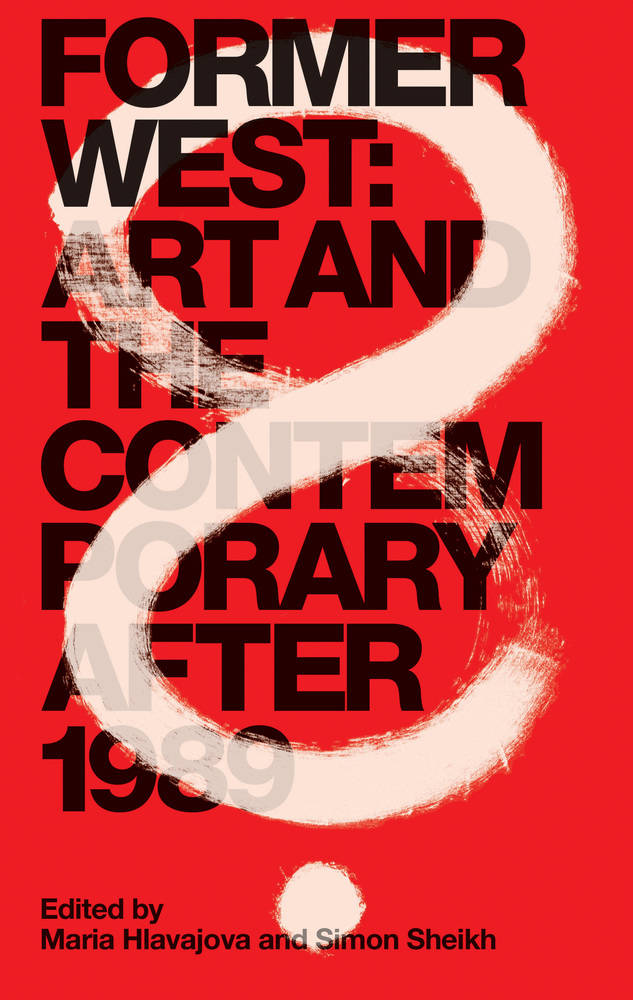FORMER WEST: Art and the Contemporary after 1989
FORMER WEST: Art and the Contemporary After 1989
Edited by Maria Hlavajova and Simon Sheikh
Out 10 March 2017. Orders through MIT Press
What has become of the so-called West after the Cold War? After the tripartite division of the world into first, second, and third has been superseded? Why hasn’t the West simply become “former,” like its supposed counterpart, the “former East”?
To propose a “former West” puts a conceptual challenge to artists, thinkers, and activists to inquire into the repercussions of the political, cultural, and economic events of 1989 as they have shaped both art and the contemporary. A culmination of an eight-year curatorial research experiment, Former West: Art and the Contemporary After 1989 comprises the rich array of critical approaches and positions both imagining and inhabiting—with, along, and through art—a world beyond our immediate condition.
While the opposition of West versus East casts a provocative shadow over many responses to such queries, the contributions to the book unfold an entangled cartography of the present that is far more complex than any simplistic dichotomy could allow. Probing the distinctions established within the geopolitical order, specifically that of the global North and global South, Former West: Art and the Contemporary After 1989 seeks to collapse the post-communist condition with the postcolonial constellation, and in parallel, the cultural, political, and environmental upheavals that structure the present moment with the post-ideological, posthuman, and posthistorical formations that have emerged in intellectual and artistic response. At stake is the aftermath of the competition between West and East that defined most of the twentieth century; a contest not primarily between two ideological blocs, but between two variants of Western modernity. It is this conceptual “Westcentrism,” leaning on the economic, technological, political, and epistemological infrastructure of power and domination—as well as the resilient universalization of Western narratives—that a “formering” of the West seeks to undo.
The publication, comprising writings, visual essays, and conversations from more than 70 contributors, is divided into seven sections, each re-inscribing contemporary debates through the notion of a “former West.” It begins by rethinking the conceptions of time and space that have dominated the controversial legacy of the 1989/1990 revolutions in the former East. As the notion “former” complicates the linear understanding of time, the essays critique historical periodizations of the contemporary and address the obsessive fascination with the past that marks so much of its culture (I. 1989, Art, and the Contemporary; II. Timing the Former). Addressing creeping normalization of contemporary fascisms, neo- and post-, the successive chapters speak of the conceptual architecture of the contemporary and map its political economy, thinking through ways of “formering” its social relations (III. Understructures; IV. Toward Another Political Economy?). Related questions of power, truth, and resistance—in particular the reality of infrastructure “after the Internet”—open a discussion of the implications of algorithmic cultures and the posthuman condition (V. Power and Truth (After the Internet)). Its effect on notions of collectivity and solidarity in the present, and the tectonic impact of contemporary migration—in particular the so-called “refugee crisis” and the larger process of global class recomposition—are then considered, framed by an underlying question of how to construct a new “we” under these conditions (VI. Constructions of the “We”). Finally, the prospective trajectories assembled in the last chapter (VII. Prospects) appeal to art’s critical potential to institute the contemporary it envisions from within such cartography, and live as if it were possible.
Former West: Art and the Contemporary After 1989 is edited by curator Maria Hlavajova and writer and curator Simon Sheikh. Visual introductions to book chapters are curated by Maria Hlavajova and Kathrin Rhomberg.
Contributors include: Nancy Adajania, Edit András, Athena Athanasiou, Zygmunt Bauman, Dave Beech, Brett Bloom, Rosi Braidotti, Susan Buck-Morss, Campus in Camps, Dipesh Chakrabarty, Chto Delat?/What is to be done?, Jodi Dean, Angela Dimitrakaki, Dilar Dirik, Marlene Dumas, Keller Easterling, Okwui Enwezor, Charles Esche, Silvia Federici, Mark Fisher, Federica Giardini and Anna Simone, Boris Groys, Gulf Labor Coalition, Stefano Harney, Sharon Hayes, Brian Holmes, Tung-Hui Hu, Wendy Hui Kyong Chun, Sami Khatib, Delaine Le Bas, Boaz Levin and Vera Tollmann, Isabell Lorey, Sven Lütticken, Ewa Majewska, Artemy Magun, Suhail Malik, Teresa Margolles, Achille Mbembe, Laura McLean, Cuauhtémoc Medina, Sandro Mezzadra, Walter D. Mignolo, Aernout Mik, Angela Mitropoulos, Rastko Močnik, Nástio Mosquito, Rabih Mroué, Pedro Neves Marques, Peter Osborne, Matteo Pasquinelli, Andrea Phillips, Nina Power, Vijay Prashad, Gerald Raunig, Irit Rogoff, Boaventura de Sousa Santos, Naoki Sakai, Rasha Salti, Francesco Salvini, Christoph Schlingensief, Georg Schöllhammer, Susan Schuppli, Andreas Siekmann, Jonas Staal, Hito Steyerl, Mladen Stilinović, Paulo Tavares, Trịnh T. Minh-Hà, Mona Vătămanu and Florin Tudor, Marina Vishmidt, Marion von Osten, McKenzie Wark, and Eyal Weizman.
Former West: Art and the Contemporary After 1989 is a culmination of FORMER WEST (www.formerwest.org), a collective and nomadic project of inquiry initiated and developed by BAK, basis voor actuele kunst, Utrecht from 2008–2016. The project undertook a research trajectory that was brought to life through a series of congresses, exhibitions, publications, educational platforms, and discursive programs realized in various solidarity constellations with artistic and educational institutions worldwide. Leading up to this publication, a series of public editorial meetings were held in Berlin (2013), Utrecht (2014), London (2015), Budapest (2015), and Warsaw (2015), in which themes, contributions, and propositions for this publication were considered in dialogue with the public.
Published by BAK, basis actuele kunst and MIT Press, 2016 | Design by Mevis & Van Deursen, Amsterdam | English language | 748 pages | Paperback | ISBN: 9780262533836The publication can be ordered via MIT Press. For updates concerning the publication and related activities, please subscribe to the FORMER WEST publication mailing list by sending an e-mail to info@formerwest.org.
